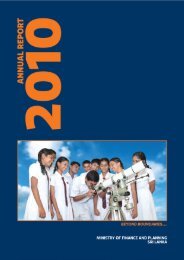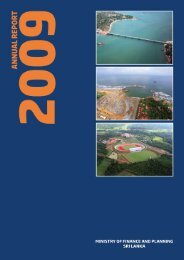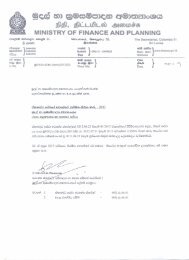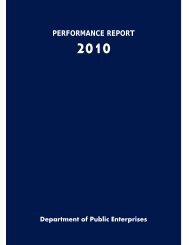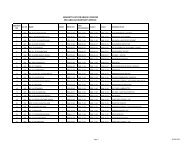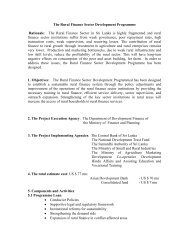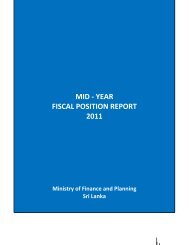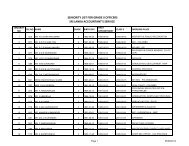Annual Report 2008 - Ministry of Finance and Planning
Annual Report 2008 - Ministry of Finance and Planning
Annual Report 2008 - Ministry of Finance and Planning
Create successful ePaper yourself
Turn your PDF publications into a flip-book with our unique Google optimized e-Paper software.
6. A Sectoral Perspective<br />
250<br />
Livestock<br />
The livestock sector mainly consists <strong>of</strong> the dairy <strong>and</strong> poultry<br />
sub sectors. The special attention has been paid for the<br />
development <strong>of</strong> the livestock sector which is considered as<br />
one <strong>of</strong> the high priority areas for future growth, investment <strong>and</strong><br />
poverty alleviation. A number <strong>of</strong> priority programmes were<br />
implemented in order to improve breeds, the availability <strong>of</strong><br />
quality fodder/pasture, better animal health, <strong>and</strong> a developed<br />
collection network. The Dairy Village Programme, Liquid<br />
Milk Consumption Promotion Programme, Improvement<br />
<strong>of</strong> Service Delivery System, Calf Rearing Programme, <strong>and</strong><br />
Livestock Breeding Project continued in <strong>2008</strong> with a greater<br />
participation <strong>of</strong> the privet sector.<br />
Steps have been taken to establish a Veterinary Hospital at<br />
Nuwara-Eliya <strong>and</strong> three Veterinary Investigation Centres<br />
(VICs) in Colombo, Ampara <strong>and</strong> Trincomalee with the aim<br />
<strong>of</strong> providing effective disease investigations <strong>and</strong> diagnosis<br />
facilities. In addition, 148 Divisional Veterinary Offices<br />
have been equipped to improve the service delivery system.<br />
Nearly 9,000 improved heifer calves were distributed among<br />
farmers under the Heifer Calf Rearing Project in <strong>2008</strong>. Animal<br />
Act No. 29 <strong>of</strong> 1958 was amended with the aim <strong>of</strong> controlling<br />
the slaughtering <strong>of</strong> breedable cows which is the major cause<br />
<strong>of</strong> depletion <strong>of</strong> cattle population.<br />
The livestock sector in real terms grew by 5.6 percent in<br />
<strong>2008</strong> <strong>and</strong> the contribution <strong>of</strong> the sector to the GDP amounted<br />
nearly 1 percent. The total milk production reached to 208<br />
million litres in <strong>2008</strong>, an increase <strong>of</strong> 3 percent over 2007. This<br />
includes 172 million litres <strong>of</strong> cow milk <strong>and</strong> 36 million litres<br />
<strong>of</strong> buffaloes milk. At present, 26 percent <strong>of</strong> national milk<br />
requirement is met by the local production indicating the<br />
importance <strong>of</strong> diverting more resources on milk production<br />
to achieve the envisaged target <strong>of</strong> 50 percent self sufficiency<br />
by 2015.<br />
The Government heavily intervened in the promotion <strong>of</strong><br />
Liquid Milk Consumption Programmes in <strong>2008</strong> with greater<br />
private sector participation. The year <strong>2008</strong> was declared as<br />
“Kiri Ithurum Mangalya” to create awareness among public<br />
on the value <strong>of</strong> fresh milk consumption. 67 dairy villages,<br />
38 animal breeding farms have been established benefiting<br />
Towards the Healthy Nation: Fresh Milk Consumption Outlet<br />
1,538 farm families during the year <strong>2008</strong>. In addition, 154<br />
fresh milk sales centers <strong>and</strong> 30 milk chilling centers have<br />
also been established in view <strong>of</strong> promoting fresh milk<br />
consumption in the country.<br />
Fisheries <strong>and</strong> Aquatic Resources<br />
The highest ever annual fish production was recorded in <strong>2008</strong><br />
amounting to 319,000 metric tons, a 10 percent increase over<br />
2007. This constitutes <strong>of</strong> 275,000 metric tons <strong>of</strong> marine fish<br />
production <strong>and</strong> 44,000 metric tons <strong>of</strong> aquaculture <strong>and</strong> inl<strong>and</strong><br />
fisheries. The marine fish production <strong>and</strong> the inl<strong>and</strong> <strong>and</strong><br />
aquaculture fish production grew by 8.7 per cent <strong>and</strong> 16 per<br />
cent respectively with the resumption <strong>of</strong> economic activities<br />
in the East coast <strong>and</strong> the favourable weather condition.<br />
Several measures have been taken to increase fish<br />
production in promoting <strong>of</strong>fshore <strong>and</strong> deep sea fishing. The<br />
selected fishermen were given a subsidy for the construction<br />
<strong>of</strong> 58 multi-day boats <strong>and</strong> 25 one -day boats in the year.<br />
The fishing fleet was increased by 7 per cent in <strong>2008</strong> due<br />
to granted subsidies <strong>and</strong> other development interventions.<br />
Rehabilitation <strong>of</strong> all the existing fishery harbours <strong>and</strong> the<br />
construction <strong>of</strong> 3 new fishery harbours at Hambantota,<br />
Ambalangoda <strong>and</strong> Chilaw were completed. The preliminary<br />
work for the construction <strong>of</strong> Dickowita fishery harbour has<br />
been undertaken in <strong>2008</strong> <strong>and</strong> expected to be completed<br />
by 2010. Action was taken to improve the anchorages at<br />
Sainthamaruthu, Vakarai, Suduwella, Kinniya <strong>and</strong> Kaikawala<br />
with the support <strong>of</strong> donor funds.<br />
<strong>Ministry</strong> <strong>of</strong> <strong>Finance</strong> <strong>and</strong> <strong>Planning</strong> Sri Lanka<br />
<strong>Annual</strong> <strong>Report</strong> <strong>2008</strong>



